Avoiding Local Photo Clichés at Destination Weddings
June 15, 2015
Destination weddings can be a dream for photographers: They are a chance to travel to a foreign locale and offer an abundance of inspiring visual stimuli. But it can be tempting to allow a beautiful environment to do all the work and not venture beyond mundane poses or the most obvious icons of the destination. We spoke with five photographers to hear their processes for creating dynamic imagery that takes the wedding beyond innately beautiful environs.
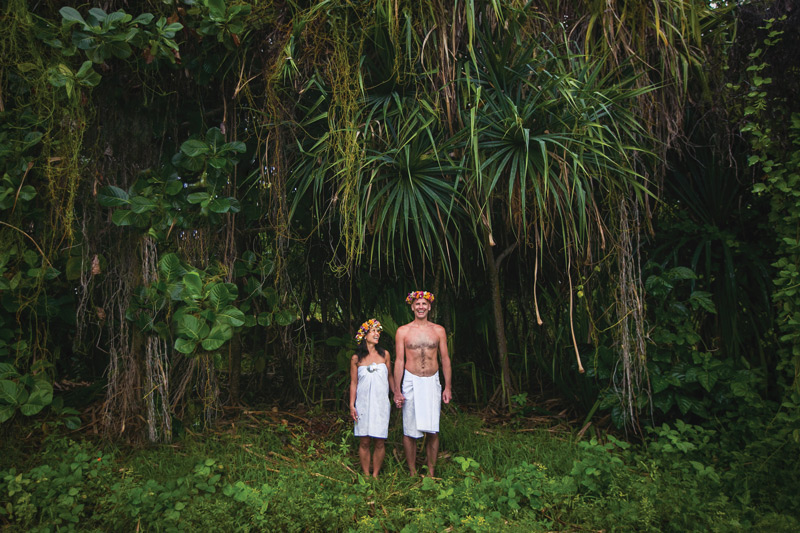
Photo © Callaway Gable
Let Culture Shine
Dismissing local customs or traditional ephemera can lead to images without context. To tell the story of a place, Allison and Brian of Callaway Gable encouraged a recent couple to incorporate local Tahitian wedding customs into their ceremony. “During their wedding they wore Western attire with traditional Tahitian floral leis and crowns. Later they changed into Tahitian pareos in a very special and intimate ceremony. Local Tahitians wrapped the garments around Ann and Conrad in a chapel with a view of Bora Bora’s extinct volcano. It still gives me goosebumps when I look at those photos,” Brian says.
Their advice for capturing a foreign culture (aside from not being afraid to get in the water or traverse jungle terrain)? “Stay with the locals, if possible,” Brian says. “When we went to Bora Bora, we stayed on the mainland where no one spoke English—only French. It really gave us a sense of the local people and their culture.”
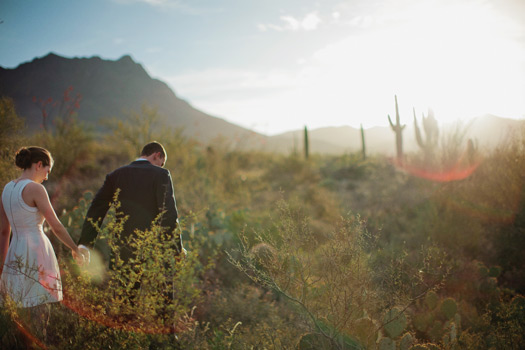
Photo © Love is a Big Deal
Change Your Perspective
For a recent desert wedding, Josh and Meg of Love is a Big Deal told their couple to “take a walk” before they captured a perfectly rim-lit image of the two strolling hand-in-hand through a dusky Arizona desert landscape (above). Giving the couple a moment alone, their tip for creating interesting composition is to think beyond the Rule of Thirds. “We are always thinking ‘wide, medium, tight’ at every shoot,” the duo says. “If you do this for every moment, you make sure you’re getting variety and covering all of your bases.”
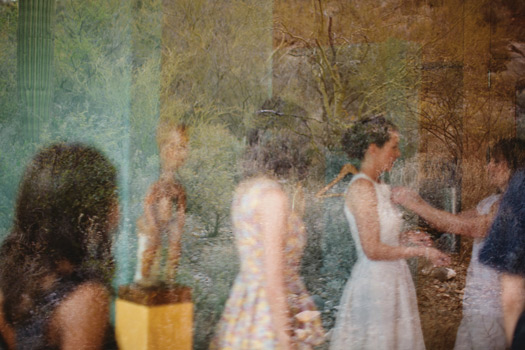
Photo © Love is a Big Deal
The photographers also think outside of the box—literally. At the same Arizona wedding, “the venue was a rectangle box just sitting in the middle of this great landscape. It was great to incorporate these geometric lines with Arizona’s earthy feel,” they explain. In order to put a unique spin on an image of the bridal party getting ready, they shot through the glass structure, allowing the cacti to be incorporated into a multi-dimensional shot.
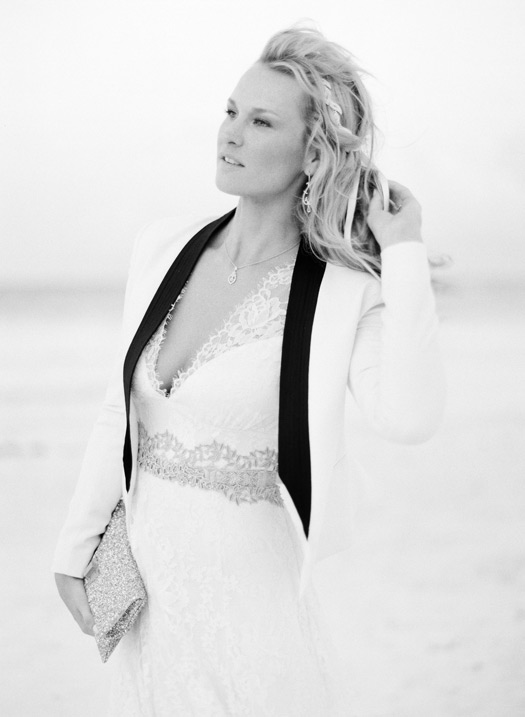
Photo © KT Merry
Make it Black and White
While it might be instinctual to photograph a beautiful location in color, one way to direct attention differently within an image is to think in a monochromatic palette. This is what photographer KT Merry did when she shot a beach destination wedding—she decided to ditch color for a portrait of the bride. “I loved her editorial look with the blazer over the wedding dress, and felt that black and white would capture that editorial mood and enhance the image even further,” she says.
Merry often chooses to shoot with black-and-white film when the light is muted by an overcast sky, she says. “When choosing to shoot something in black and white, I will make the decision based on the lighting situation and content of the image. Certain shots, like the getting ready or cake cutting, I love to see in black and white, and sometimes the light or mood of a scenario will dictate the change.” She cautions photographers to think about density when shooting in black and white: “If the image is dark and muddy, then it can lose its impact. Good exposure and soft lighting are two things I look for.”
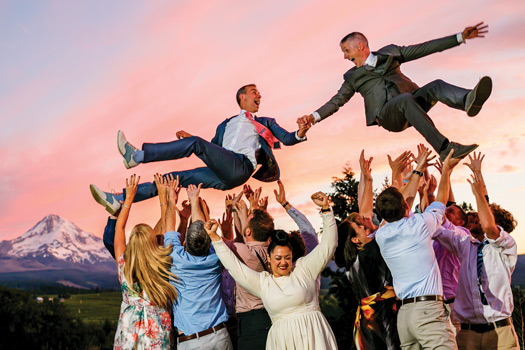
Photo © JOS Studios
Play with Light
Just because a wedding is outdoors, doesn’t mean the lighting has to be au naturel, too. Balancing artificial light with natural light may be just the ingredient to give an image depth. Jos and Tree of JOS Studios explain that sometimes the simple modifiers are the best for creating dynamic lighting. “Knowing how to bounce light, how close or far to place a diffusor near a face, or feather one light more than the other can create entirely different looks,” Jos says.
When asked to photograph at Mt. Hood Organic Farms in Oregon, they knew that Mt. Hood would have to factor into the images. “We love how the metaphor of a mountain says something poetic. Yet we also wanted something different and dynamic,”
they say.
So the photographers shot the wedding party from a low vantage point to give their subjects definition, “especially against a wild pink sky!” The image was exposed for the light on the mountain and then shot with a transmitter to trigger two external flashes to light up the couple from a 45-degree angle where the sun would naturally shine.
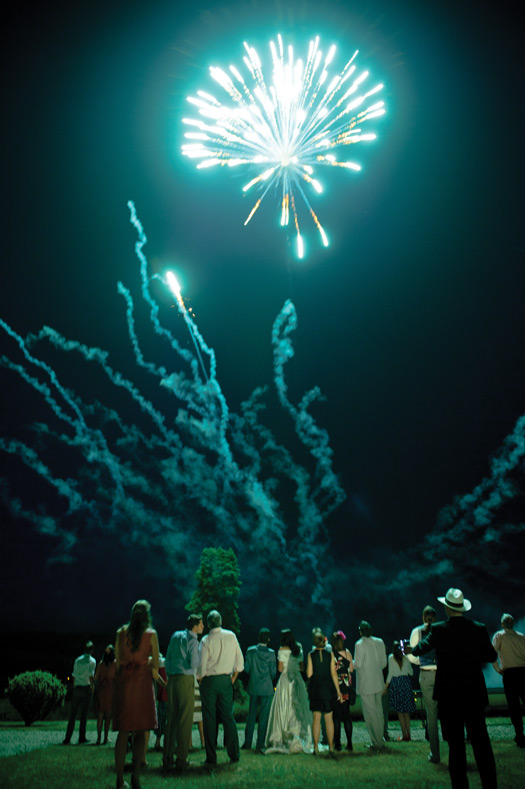
Photo © Jean-Pierre Uys
Emphasize Spatial Relationships
Some of the most captivating imagery can simply come from understanding how your subjects interact within their environment and waiting for those special moments to occur. Photographer Jean-Pierre Uys spends a few days ahead of time looking at the venue and figuring out how to emphasize the scene. Then he looks at how the people enter the scene. “I show the vastness of the space and then how the people fit within it,” he says.
For a wedding in southern France, he “wanted to show the guests with the couple enjoying the fireworks,” Uys says. “I love to capture people having fun within the environment. I think it’s important you can see it’s a destination. You have to look for something that captures the essence of the location.”
DESTINATION PITFALLS TO AVOID
1. Landscape Overload
One no-no—advise Josh and Meg of Love is a Big Deal—is turning into a landscape photographer by concentrating too much on the surroundings and forgetting the main reason you are there in the first place: the bride and groom. “How many photos have we all seen of a couple in Iceland so small that you can barely see them?” they ask. “But you sure can see that mountain or glacier.”
2. Fake Faces
“Contrived posing; forced smiles; subjects looking directly into the camera; awkwardly stiff stances; flat, muddy light; overshooting the same angle of monuments,” are tired habits to avoid, say the team behind JOS Studios. “This doesn’t mean shooting symbolic things is wrong; we just think breaking the rules and doing something artistic and more emotional with a raw edge better represents professional photography.”
3. Unsteady Style
“Photographers often change their style for a destination wedding,” says KT Merry. “I think it’s crucial to approach destination weddings with the same shooting style of all your photography. I use the new location to inspire me to think outside of the box and try new things while keeping true to my style throughout.”
4. Tired Snaps
Stop shooting what everyone else does, says Brian of Callaway Gable. “If it’s a beach wedding, it would be taking wedding photos at the beach. It’s easy and it’s what every other photographer does; we would encourage you to look beyond the easy, and find something extraordinary.”
5. Played-Out Poses
“Regardless of the destination, clichés lie in the way you pose the couple,” says Jean-Pierre Uys. “The natural beauty on its own breaks clichés, but if you do a cliché pose, it will look cliché in any environment.”




